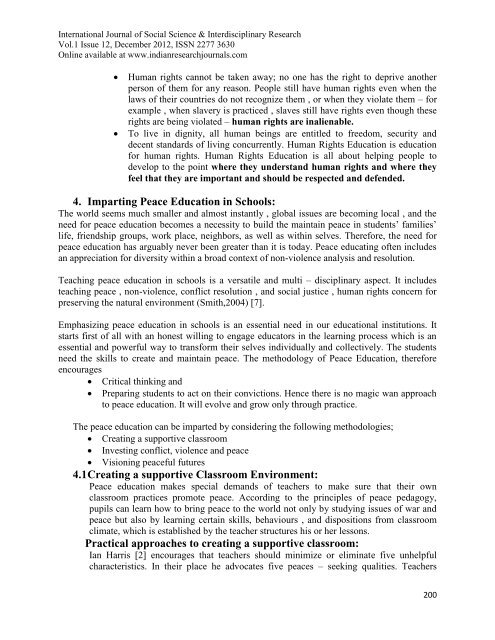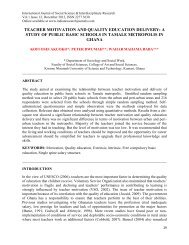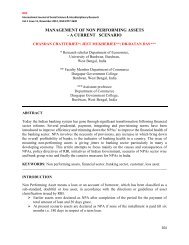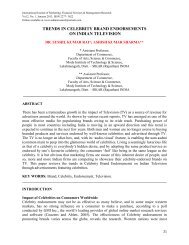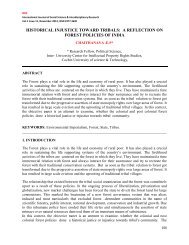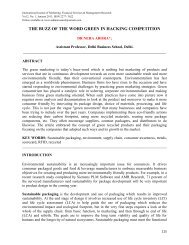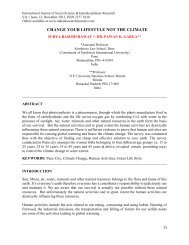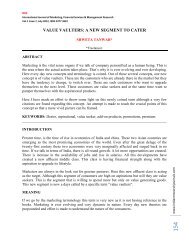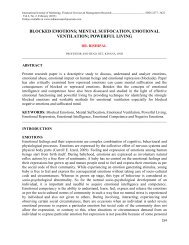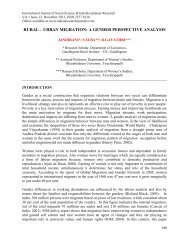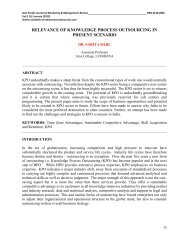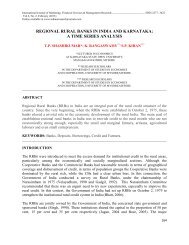PEACE EDUCATION AND HUMAN RIGHTS IN TWENTY FIRST ...
PEACE EDUCATION AND HUMAN RIGHTS IN TWENTY FIRST ...
PEACE EDUCATION AND HUMAN RIGHTS IN TWENTY FIRST ...
Create successful ePaper yourself
Turn your PDF publications into a flip-book with our unique Google optimized e-Paper software.
International Journal of Social Science & Interdisciplinary Research<br />
Vol.1 Issue 12, December 2012, ISSN 2277 3630<br />
Online available at www.indianresearchjournals.com<br />
<br />
<br />
Human rights cannot be taken away; no one has the right to deprive another<br />
person of them for any reason. People still have human rights even when the<br />
laws of their countries do not recognize them , or when they violate them – for<br />
example , when slavery is practiced , slaves still have rights even though these<br />
rights are being violated – human rights are inalienable.<br />
To live in dignity, all human beings are entitled to freedom, security and<br />
decent standards of living concurrently. Human Rights Education is education<br />
for human rights. Human Rights Education is all about helping people to<br />
develop to the point where they understand human rights and where they<br />
feel that they are important and should be respected and defended.<br />
4. Imparting Peace Education in Schools:<br />
The world seems much smaller and almost instantly , global issues are becoming local , and the<br />
need for peace education becomes a necessity to build the maintain peace in students‟ families‟<br />
life, friendship groups, work place, neighbors, as well as within selves. Therefore, the need for<br />
peace education has arguably never been greater than it is today. Peace educating often includes<br />
an appreciation for diversity within a broad context of non-violence analysis and resolution.<br />
Teaching peace education in schools is a versatile and multi – disciplinary aspect. It includes<br />
teaching peace , non-violence, conflict resolution , and social justice , human rights concern for<br />
preserving the natural environment (Smith,2004) [7].<br />
Emphasizing peace education in schools is an essential need in our educational institutions. It<br />
starts first of all with an honest willing to engage educators in the learning process which is an<br />
essential and powerful way to transform their selves individually and collectively. The students<br />
need the skills to create and maintain peace. The methodology of Peace Education, therefore<br />
encourages<br />
<br />
<br />
Critical thinking and<br />
Preparing students to act on their convictions. Hence there is no magic wan approach<br />
to peace education. It will evolve and grow only through practice.<br />
The peace education can be imparted by considering the following methodologies;<br />
Creating a supportive classroom<br />
Investing conflict, violence and peace<br />
Visioning peaceful futures<br />
4.1 Creating a supportive Classroom Environment:<br />
Peace education makes special demands of teachers to make sure that their own<br />
classroom practices promote peace. According to the principles of peace pedagogy,<br />
pupils can learn how to bring peace to the world not only by studying issues of war and<br />
peace but also by learning certain skills, behaviours , and dispositions from classroom<br />
climate, which is established by the teacher structures his or her lessons.<br />
Practical approaches to creating a supportive classroom:<br />
Ian Harris [2] encourages that teachers should minimize or eliminate five unhelpful<br />
characteristics. In their place he advocates five peaces – seeking qualities. Teachers<br />
200


